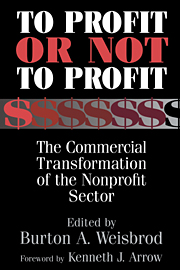Book contents
- Frontmatter
- Contents
- List of contributors
- Foreword by Kenneth J. Arrow
- Preface
- 1 The nonprofit mission and its financing: Growing links between nonprofits and the rest of the economy
- Part I Basic issues and perspective
- Part II Industry studies
- 8 Commercialism in nonprofit hospitals
- 9 Universities as creators and retailers of intellectual property: Life-sciences research and commercial development
- 10 Commercialism in nonprofit social service associations: Its character, significance, and rationale
- 11 Zoos and aquariums
- 12 Commerce and the muse: Are art museums becoming commercial?
- 13 The funding perils of the Corporation for Public Broadcasting
- Part III Overview, conclusions, and public-policy issues
- Appendix: IRS Forms 990 and 990-T for nonprofit organizations
- References
- Index
8 - Commercialism in nonprofit hospitals
Published online by Cambridge University Press: 30 November 2009
- Frontmatter
- Contents
- List of contributors
- Foreword by Kenneth J. Arrow
- Preface
- 1 The nonprofit mission and its financing: Growing links between nonprofits and the rest of the economy
- Part I Basic issues and perspective
- Part II Industry studies
- 8 Commercialism in nonprofit hospitals
- 9 Universities as creators and retailers of intellectual property: Life-sciences research and commercial development
- 10 Commercialism in nonprofit social service associations: Its character, significance, and rationale
- 11 Zoos and aquariums
- 12 Commerce and the muse: Are art museums becoming commercial?
- 13 The funding perils of the Corporation for Public Broadcasting
- Part III Overview, conclusions, and public-policy issues
- Appendix: IRS Forms 990 and 990-T for nonprofit organizations
- References
- Index
Summary
Introduction
Most U.S. hospitals are organized as private, not-for-profit organizations. Although the share of such hospitals is declining, as of 1994, 60 percent of nonfederal, short-term general hospitals were nonprofits; only 12 percent were proprietary, and the rest were government hospitals (AHA 1995). Private nonprofit hospitals, measured in terms of GNP, constitute by far the largest category of nonprofit institutions in the United States.
The hospital industry is undergoing massive change. Partly because of modifications in payment practices, demand for hospital inpatient care is shrinking, leading to hospital closures and mergers as well as some conversions to forprofit status. Hospitals are integrating not only horizontally but also vertically, the latter including combinations with other types of health-care providers and, mainly through contracting, the establishment of links to health-insurance plans. Entry of capitated health plans has introduced a dose of competition into the health-care sector, which in turn is adding to competitive pressures on hospitals and appears to have made them more commercial than heretofore.
The changes that are occurring raise several important public-policy concerns. The social expectation is that even persons who are disadvantaged because of their health, low income, or other factors, such as race or ethnicity, have access to needed care of high quality. Some hospitals have engaged in teaching and research, supported in part by profits from patient service and explicit subsidies. By virtue of their ownership status, it is also expected that at least some nonprofit hospitals will engage in these noncommercial activities.
- Type
- Chapter
- Information
- To Profit or Not to ProfitThe Commercial Transformation of the Nonprofit Sector, pp. 151 - 168Publisher: Cambridge University PressPrint publication year: 1998
- 15
- Cited by



